Related Research Articles

Anne was Queen of Great Britain and Ireland following the ratification of the Acts of Union on 1 May 1707, which merged the kingdoms of Scotland and England. Before this, she was Queen of England, Scotland, and Ireland from 8 March 1702.

General John Churchill, 1st Duke of Marlborough, 1st Prince of Mindelheim, 1st Count of Nellenburg, Prince of the Holy Roman Empire, was an English soldier and statesman. From a gentry family, he served as a page at the court of the House of Stuart under James, Duke of York, through the 1670s and early 1680s, earning military and political advancement through his courage and diplomatic skill. He is known for never having lost a battle.

Sarah Churchill, Duchess of Marlborough, Princess of Mindelheim, Countess of Nellenburg, was an English courtier who rose to be one of the most influential women of her time through her close relationship with Anne, Queen of Great Britain. The Duchess of Marlborough's relationship and influence with Anne were widely known, and leading public figures often turned their attentions to her, hoping for favour from Anne.
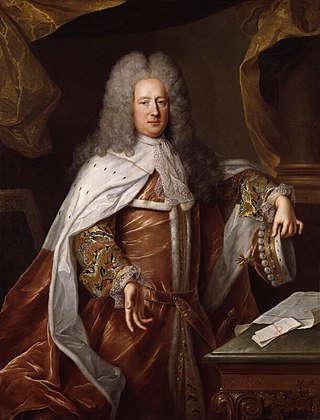
Henry St John, 1st Viscount Bolingbroke was an English politician, government official and political philosopher. He was a leader of the Tories, and supported the Church of England politically despite his antireligious views and opposition to theology. He supported the Jacobite rebellion of 1715 which sought to overthrow the new king George I. Escaping to France he became foreign minister for James Francis Edward Stuart. He was attainted for treason, but reversed course and was allowed to return to England in 1723. According to Ruth Mack, "Bolingbroke is best known for his party politics, including the ideological history he disseminated in The Craftsman (1726–1735) by adopting the formerly Whig theory of the Ancient Constitution and giving it new life as an anti-Walpole Tory principle."
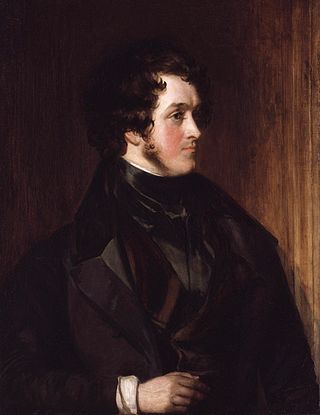
William Harrison Ainsworth was an English historical novelist born at King Street in Manchester. He trained as a lawyer, but the legal profession held no attraction for him. While completing his legal studies in London he met the publisher John Ebers, at that time manager of the King's Theatre, Haymarket. Ebers introduced Ainsworth to literary and dramatic circles, and to his daughter, who became Ainsworth's wife.

Robert Harley, 1st Earl of Oxford and Earl Mortimer, KG PC FRS was an English statesman and peer of the late Stuart and early Georgian periods. He began his career as a Whig, before defecting to a new Tory ministry. He was raised to the peerage of Great Britain as an earl in 1711. Between 1711 and 1714 he served as Lord High Treasurer, effectively Queen Anne's chief minister. He has been called a prime minister, although it is generally accepted that the de facto first minister to be a prime minister was Robert Walpole in 1721.

This is a list of the principal Ministers of the Crown of the Kingdom of England, and then of the Kingdom of Great Britain, from May 1702, at the beginning of the reign of Queen Anne. During this period, the leaders of the ministry were Lord Godolphin and the Duke of Marlborough.

Abigail Masham, Baroness Masham, was an English courtier. She was a favourite of Queen Anne, and a cousin of Sarah, Duchess of Marlborough.
Major-General John "Jack" Hill was a British army officer and courtier during the reign of Queen Anne. While of no particular military ability, his family connections brought him promotion and office until the end of Anne's reign.
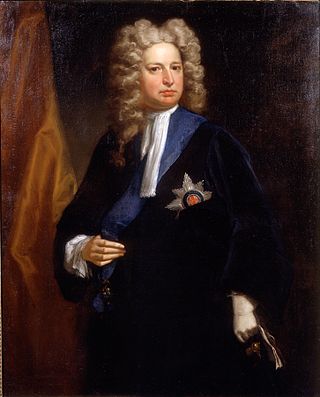
The Harleyministry was the British government that existed between 1710 and 1714 in the reign of Queen Anne. It was headed by Robert Harley and composed largely of Tories. Harley was a former Whig who had changed sides, bringing down the seemingly powerful Whig Junto and their moderate Tory ally Lord Godolphin. It came during the Rage of Party when divisions between the two factions were at their height, and a "paper war" broke out between their supporters. Amongst those writers supportive of Harley's government were Jonathan Swift, Daniel Defoe, Delarivier Manley, John Arbuthnot and Alexander Pope who clashed with members of the rival Kit-Kat Club.
Artist and the Author is a pamphlet written by George Cruikshank in 1872. During the late 1860s, Cruikshank claimed to be the author of works attributed to other writers, including Charles Dickens and William Harrison Ainsworth. After John Forster contradicted Cruikshank's claims to having "originated" Oliver Twist, Cruikshank began a dispute in The Times as being the creator of novels attributed to Ainsworth. After the newspaper stopped carrying the dispute, Cruikshank produced all of his claims in Artist and the Author, where he disputed his relationship to 8 of Ainsworth's novels.

Windsor Castle is a novel by William Harrison Ainsworth serially published in 1842. It is a historical romance with gothic elements that depicts Henry VIII's pursuit of Anne Boleyn. Intertwined with the story are the actions of Herne the Hunter, a legendary ghost that haunts Windsor woods.
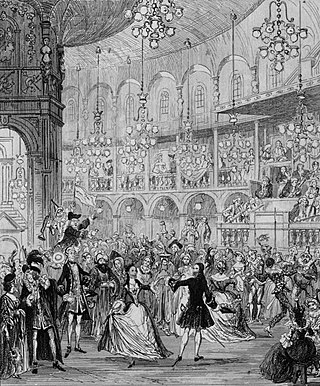
The Miser's Daughter is a novel by William Harrison Ainsworth serially published in 1842. It is a historical romance that describes a young man pursuing the daughter of a miserly rich man during the 18th century.

Jack Sheppard is a novel by William Harrison Ainsworth serially published in Bentley's Miscellany from 1839 to 1840, with illustrations by George Cruikshank. It is a historical romance and a Newgate novel based on the real life of the 18th-century criminal Jack Sheppard.
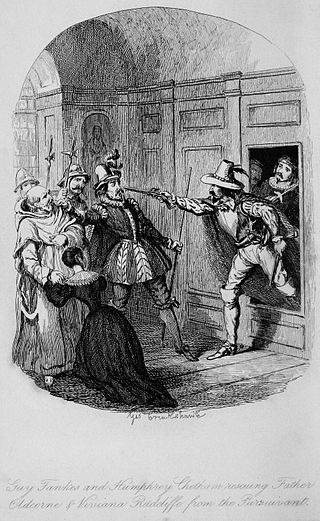
The novel Guy Fawkes first appeared as a serial in Bentley's Miscellany, between January and November 1840. It was subsequently published as a three-volume set in July 1841, with illustrations by George Cruikshank. The first of William Harrison Ainsworth's seven "Lancashire novels", the story is based on the Gunpowder Plot of 1605, an unsuccessful attempt to blow up the Houses of Parliament. Ainsworth relied heavily on historical documents describing the trial and execution of the conspirators, of whom Fawkes was one, but he also embellished the known facts. He invented the character of Viviana Radcliffe, daughter of the prominent Radcliffe family of Ordsall Hall – who becomes Fawkes's wife – and introduced gothic and supernatural elements into the story, such as the ability of the alchemist, John Dee, to raise the spirits of the dead.
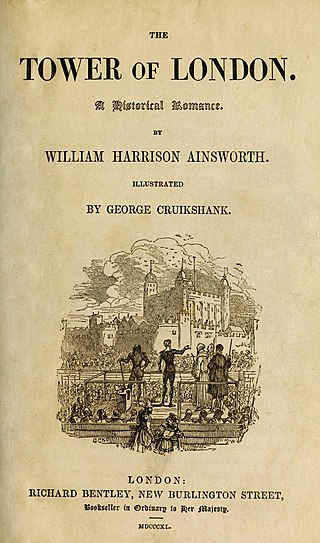
The Tower of London is a novel by William Harrison Ainsworth serially published in 1840. It is a historical romance that describes the history of Lady Jane Grey from her short-lived time as Queen of England to her execution.

Old St. Paul's, also titled Old Saint Paul's: A Tale of the Plague and the Fire, is a novel by William Harrison Ainsworth serially published in 1841. It is a historical romance that describes the events of the Great Plague of London and the Great Fire of London. It was the basis for the 1914 silent film Old St. Paul's.

Rookwood is a novel by William Harrison Ainsworth published in 1834. It is a historical and gothic romance that describes a dispute over the legitimate claim for the inheritance of Rookwood Place and the Rookwood family name.
A Glass of Water is a 1979 Soviet historical melodramatic comedy television film directed by Yuli Karasik and based on the 1840 play of the same title by Eugène Scribe, set in the court of Queen Anne of Great Britain at the start of the 18th century. The play was previously adapted for film in Russia in 1957.
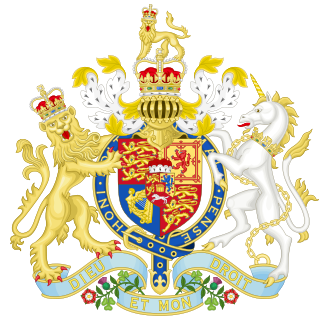
John Plunket (1664–1738), was an Irish Jacobite, a key player in the Atterbury Plot of the 1720s aimed at restoring the House of Stuart to the throne of Great Britain. He sometimes used the alias of John Rogers.
References
- Carver, Stephen. The Life and Works of the Lancashire Novelist William Harrison Ainsworth, 1805–1882. Lewiston: Edwin Mellen Press, 2003.
- Ellis, S. M. William Harrison Ainsworth and His Friends. 2 Vols. London: Garland Publishing, 1979.
- Worth, George. William Harrison Ainsworth. New York: Twayne Publishers, 1972.